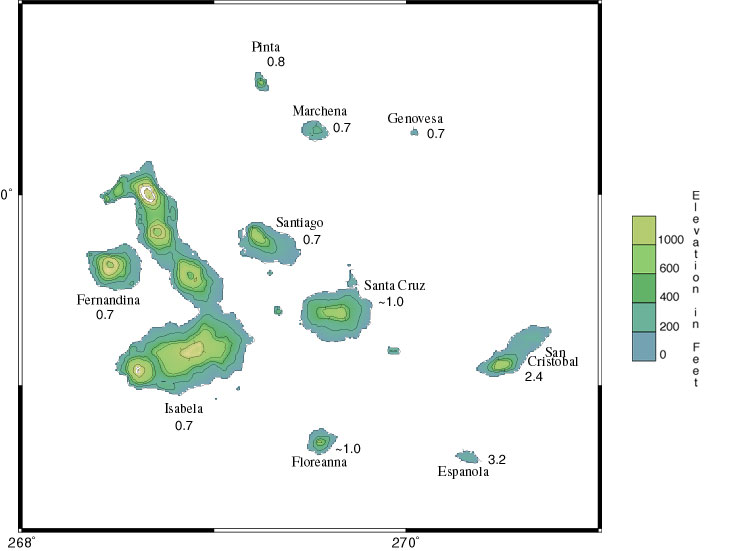|
Geomorpholgy Age of the Galapagos Islands (In Million Years)  | | Topographic data compiled by William Chadwick, Oregon State University. |
The oldest islands in the Galapagos are South Plaza of 4.2 million years (+/- 1.8) and Espanola of 3.2 million years (+/- 0.2). These dates correspond to when the island first surfaced above sea level. The submerged island bases could be up to fifteen million years old, Miocene geologic time. Dating all of the islands is possible by using a method called potassium-argon age dating, which dates the age of volcanic rocks (basalt's). The age dates of the other islands are as follows: Santa Fe is 2.7 million years (+/- 0.1); San Cristobal is 2.4 - 4 million years; Balta, Floreana, Pinzon, Rabida, Santa Cruz, and Wolf are all 0.7 - 1.5 million years; and Darwin, Fernandina, Genovesa, Isabela, Marchena, and Santiago and all 0.7 million years. The Galapagos Islands are relatively young in comparison to other oceanic islands making them they are one of the most active oceanic volcanoes in the world.
The Hawaiian archipelago is a textbook example of a hotspot-island chain. The progression of the island chain is clearly linear to the northwest starting from the main island of Hawaii. Eventually the islands disappear underwater as part of the Emperor Seamount Chain. The youngest and most active island is Hawaii consisting of rocks younger than .7 million years. Following the island chain NW, the last emerged island of Kauai has been dated at roughly 4.5-5.5 million years (Carr et. al., 1980). Migrating further the bend Northward of the Emperor Seamount Chain has been dated at 43 ma, and the northernmost seamount has been estimated at 65 ma. Thus the youngest Hawaiian volcanoes are islands, but the older ones are now seamounts, the tops of which become progressively deeper to the northwest. Many of the seamounts, however, were once islands.
Since the Carnegie and Cocos Ridges disappear into subduction zones, it is uncertain how old the Galapagos mantle plume is. A 1990 oceanographic expedition, however, did locate an 8 million-year-old seamount on the Carnegie Ridge that was certainly once an island. This volcano, though now 1500 m beneath sealevel, has rounded cobbles on a flat top, which provide clear evidence of wave erosion. Thus there have been islands in the Galapagos for at least 8 million years. The plume, however, is certainly even older. Many scientists believe that the Galapagos mantle plume is responsible for the abundant volcanic rocks of Cretaceous age that occur in the Caribbean and on the northwest margin of South America. Thus the Galapagos mantle plume could be as old as 90 million years and there may have been islands in this locality this long. This is of great importance in understanding the origin and evolution of the unique animals that occur on the Galapagos.
|







